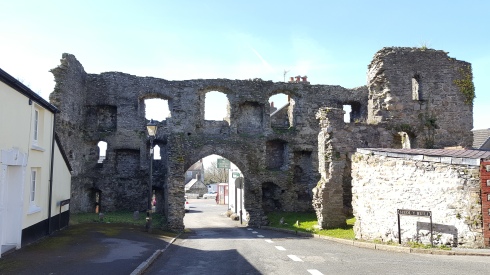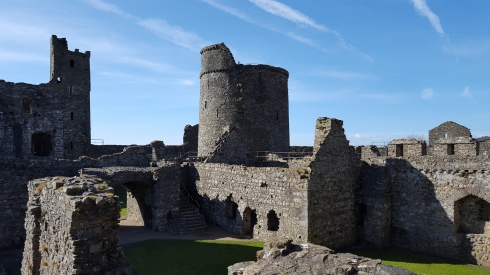
For a time in the early fifteenth century it seemed a real possibility that the Welsh rebel leader Owain Glyn Dŵr would succeed in fully driving the English out of Wales and would realise his ambition to be Prince of Wales. The failure of his rebellion was due in large part to the success of beleaguered English-held towns and castles in resisting the attacks of the Welsh. One of these places was Kidwelly in south Wales in the county of Carmarthenshire. Thanks to the survival of a series of detailed documentary evidence it is possible to reconstruct the experience of the inhabitants of the town and castle in some detail.[1]

Kidwelly dates from the twelfth century when Roger, bishop of Salisbury, ordered the construction of a castle and town to form the centre of a new lordship in south Wales from lands conquered from the native Welsh, which was populated by settlers from Normandy, Flanders and England. The castle was frequently attacked by the Welsh over the course of the twelfth and thirteenth centuries, who managed to temporarily seize control of it in 1159, 1215 and 1231. It later passed into the possession of Payne de Chaworth in 1274, who was one of Edward I’s lieutenants in the war against Llywelyn ap Gruffudd, Prince of Wales, in 1277. He was responsible for rebuilding the castle, which included the construction of the inner ward. Kidwelly was eventually acquired by John of Gaunt, duke of Lancaster, one of the sons of Edward III, who was responsible for initiating the rebuilding of the impressive south gatehouse (it was finally completed in 1422).[2]

At the turn of the fifteenth century Wales was in a state of turmoil. Unhappiness with English rule and the chaos caused by the overthrow of Richard II by his cousin Henry Bolingbroke (who became Henry IV) contributed to the outbreak of rebellions in late 1400. On 18 September 1400, a Welsh gentleman, Owain Glyn Dŵr, led a raid on the town of Ruthin, with Gwilym ap Tudor and Rhys ap Tudor later seizing control of Conwy Castle in the following April (although it was soon recovered by Prince Henry). By the end of 1401, these disparate uprisings had united under the leadership of Owain who was to claim the title of Prince of Wales. In 1402 he defeated an English army at the Battle of Bryn Glas and launched an invasion of Gwent and Glamorganshire in south-east Wales. The garrisons of English-held towns and castles were now increasingly isolated and cut off by the Welsh. In the following year Owain rampaged throughout south Wales with an army said to be over 8,000 strong, with the chronicler Adam of Usk stating that he ‘marched through Wales with a great power as far as the sea of the Severn’. The victorious Welsh quickly captured numerous castles in the region including Newcastle Emlyn, Carmarthen and Dryslwyn. Nearby Kidwelly was soon to be targeted by the rebels.[3]

Up until this point the impact of the rebellion on Kidwelly had been limited. Modest attempts had been made to improve the fortifications, with a small garrison periodically placed in the castle and small sums spent on repairing the defences. Yet it was not until the early summer of 1403 that the threat was taken seriously. A garrison was quickly assembled of seven archers and fourteen other men to defend the castle. This force was gathered just in time as the tide of war was getting closer to Kidwelly. On 5 July it was reported by John Skidmore, the constable of the isolated castle of Carreg Cennen to the north-east, that the inhabitants of Carmarthenshire, Cydweli, Carnwyllion and Iscennen had joined the rebellion. Kidwelly was now cut off by the rebels. On 13 August, a major assault was made on the settlement led by the principal Welshmen of the district and the men of the commotes of Cydweli and Carnwyllion. This attack was beaten off by the defenders, but this success was achieved at a cost. At least several of the inhabitants were killed during the fighting and major damage was inflicted to the buildings of the town, which included the old courthouse. The defenders of Kidwelly had survived the initial onslaught but the situation remained grim.[4]

By the autumn the inhabitants had withdrawn for safety within the walls of the castle and desperate appeals for help were sent to London. On 3 October 1403 the constable of the castle wrote to the king with news of the plight of the defenders. He stated that the local Welsh gentleman Henry Don with the support of all the rebels of the south of Wales and with French and Breton allies was advancing on Kidwelly Castle. They had destroyed the grain in the surrounding area and many of the inhabitants had been forced to flee to England. He implored the king to send ‘aid, rescue, and succour, for the preservation of your said Castle…or, otherwise, your said Castle and all we your lieges there, are destroyed and undone for ever’. An expedition to relieve the defenders failed to materialise but military supplies were sent to them by sea from London via Bristol late that year. The weapons sent included two guns, gunpowder, twelve lances, forty bows and six basinets (helmets). In the meanwhile, the inhabitants hurriedly repaired the defences of the castle by digging a new ditch outside the main gatehouse and food was brought in to feed the large numbers of people who had taken refuge there. A further attack was made on Kidwelly in August 1404, with the now abandoned town set on fire by the rebels, but they were unable to storm the defences of the castle.[5]

The defenders continued to remain vigilant over the following years with a garrison of between nine to twenty-one men maintained in the castle. Yet the course of events elsewhere in Wales meant that the English gradually gained the upper hand in the struggle. Despite military assistance from France, the fortunes of war eventually turned against the rebels in 1405. By 1409 the government of Henry IV had essentially regained control of Wales, although the rebellion continued as a guerrilla movement for some years to come. The Owain Glyn Dŵr rebellion had been a traumatic event for the inhabitants of Kidwelly. They suffered from being placed under siege, the loss of life and property, and were forced to experience years of hardship and fear. However, they ultimately succeeded in weathering the storm.[6]

If you want to read more about this topic then do consider having a look at my book The Castle at War in Medieval England and Wales
Bibliography
R. Davies, The Revolt of Owain Glyn Dŵr (Oxford: Oxford University Press, 1995).
C. Hingeston, ed., Royal and Historical Letters during the Reign of Henry the Fourth, volume I (London: Longman, Green, Longman, and Roberts, 1860).
John R. Kenyon, Kidwelly Castle (Cardiff: Cadw, 2007).
Dan Spencer, The Castle at War in Medieval England and Wales (Stroud: Amberley Publishing, 2018).
Image Credits
1 – Photograph of the exterior of Kidwelly Castle taken by Dan Spencer.
2 – Photograph of the main gatehouse of Kidwelly Castle taken by Dan Spencer.
3 – Seal of Owain Glyndŵr from Wikipedia. Author: de:Benutzer:Rdb.
4 – Photograph of the town gate of Kidwelly taken by Dan Spencer.
5 – Photograph of the gatehouse and town of Kidwelly as viewed from the inner ward of Kidwelly Castle taken by Dan Spencer.
6 – Photograph of the inner ward of Kidwelly Castle taken by Dan Spencer.
7 – Photograph of the inner ward of Kidwelly Castle taken by Dan Spencer.
References
[1] The best account of this episode is by R. R. Davies, The Revolt of Owain Glyn Dŵr (Oxford: Oxford University Press, 1995), pp. 273-5. For my own account see, Dan Spencer, The Castle at War in Medieval England and Wales (Stroud: Amberley Publishing, 2018), pp. 210-14.
[2] For a history of Kidwelly Castle see, John R. Kenyon, Kidwelly Castle (Cardiff: Cadw, 2007).
[3] Spencer, The Castle at War in Medieval England and Wales, pp. 203-10; Davies, The Revolt of Owain Glyn Dŵr, pp. 102-113.
[4] Spencer, The Castle at War in Medieval England and Wales, pp. 210-11; Davies, The Revolt of Owain Glyn Dŵr, pp. 272-4.
[5] Spencer, The Castle at War in Medieval England and Wales, p. 211; F. C. Hingeston, ed., Royal and Historical Letters during the Reign of Henry the Fourth, volume I (London: Longman, Green, Longman, and Roberts, 1860), pp. 160-2; Davies, The Revolt of Owain Glyn Dŵr, pp. 274-5.
[6] Davies, The Revolt of Owain Glyn Dŵr, pp. 118-26, 276; Spencer, The Castle at War in Medieval England and Wales, pp. 212-17.
